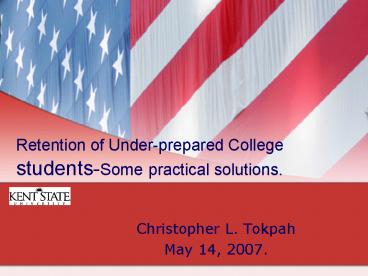Christopher L' Tokpah - PowerPoint PPT Presentation
1 / 47
Title:
Christopher L' Tokpah
Description:
Perceived irrelevance. WHY DO STUDENTS LEAVE? Psychosocial Reasons. Social factors ... Students have different levels of academic preparation when they graduate ... – PowerPoint PPT presentation
Number of Views:22
Avg rating:3.0/5.0
Title: Christopher L' Tokpah
1
Retention of Under-prepared College students-Some
practical solutions.
- Christopher L. Tokpah
- May 14, 2007.
2
HOW DO STUDENTS LEAVE?
- Leave and tell
- Leave without telling
- Required to leave
- Take a break but intend to return
- Move from one institution to another
3
WHY DO STUDENTS LEAVE?
- Academic Reasons
- Inadequate preparation
- Boredom with delivery
- Motivation
- Low commitment to college
- Perceived irrelevance
4
WHY DO STUDENTS LEAVE?
- Psychosocial Reasons
- Social factors
- Emotional factors
- Financial Reasons
- Inability (perceived) to pay for college
- Perception that cost exceeds benefits
- (Coseo, Marymount College)
5
COLLEGE READINESS
6
College Readiness
- Students have different levels of academic
preparation when they graduate from high school. - Academic preparation is a function of school
district - Only about 50 of the teachers in schools with at
least 90 minority enrollment meet their states
minimum requirements to teach
7
Percentage of Teachers without Major/Minor in
Field
8
College Readiness
- Only 32 of students who graduate from secondary
school are prepared for college level courses - Only 20 Blacks and 16 Hispanics leave high
school college-ready (Green and Forster, 2003)
9
Graduating Class of 2005
- 2005 High School Transcript Study
- Sample of 26,000 graduates
- 640 Public and 80 Private Schools
10
College Readiness
11
College Readiness
12
Graduating Class of 2005
13
College Readiness
- The level of achievement required for students
to have a high probability of success (a 75
percent chance of earning a course grade of C or
better) in such credit-bearing college courses
as English, Algebra, and Biology (ACT)
14
Graduating Class of 2006
- Total sample1,206,455
- College Readiness Scores on the ACT
- English18
- Science24
- Math22
- Reading21
15
Graduating Class of 2006
16
Graduating Class of 2006
17
Graduating Class of 2006
18
Graduating Class of 2006
19
Graduating Class of 2006
20
KSU College Readiness
21
KSU College Readiness
22
KSU College Readiness
23
Comparative Institutional Research Program (CIRP)
- CIRP is the largest and oldest source empirical
study of higher education data. - Started in 1966, CIRP has data on 1,800
institutions and over 11 million students. - Surveys gt425,000 freshmen annually
24
College Readiness
25
College Readiness
26
College Readiness
27
College Readiness
- About 75 of students enter some form of
postsecondary education within two years of
graduation from high school - 2 out of every 3 students attend either a
four-year public institution or a two-year public
institution - Approximately 50 of students require some form
of remediation
28
Retention Issues
29
THE COST
30
The Cost
- Decline in Wages
- Taxes to Govt
- Personal satisfaction
- Unpaid student loan
- 1 increase in 1st year retention rate500,000
additional revenue by the time students graduate
(Nicol Sutton)-University of St. Louis
31
Some Suggested Remedies
32
Retention Approach
- Comprehensive
- Approached like a grant (Dr. Padak)
- Needs Assessment
- Goals Objectives
- Plan of Operation
- Budget
- Evaluation
33
Some Key Retention Focus Points
PLACEMENT
ADMISSION
RETENTION
TEACHING
ACADEMIC SUPPORT
34
Admission
- Recruit better students???
- Develop an academic profile of key feeder school
districts - Communicate with district heads about
successes/challenges - Collaborate with high schools to help develop
students college-readiness
35
Placement
- Comprehensive and periodic review of placement
system - Initial Placement and sequencing should be based
on prerequisite and co-requisite - Encourage students to consider teaching habits of
faculty members
36
Teaching
- Put best faculty members in freshmen courses
- Close collaboration between faculty and academic
support services - Interactive and experiential learning
- Reward faculty members who foster retention
37
Academic Support
- Tutoring
- Time management
- Study Test-taking skills
- Consider embedding tutoring in courses.
38
Students on Academic Probation
39
Top 10 Reasons
- Lack of Potential
- Inadequate conception of the work involved
- Importance of other activities over school
- Interference from psychological problems
- Failure to assume responsibility for own learning
40
Top 10 Reasons
- Poor language (reading/writing)
- Lack of understanding of standards of high
quality performance - Selection of inappropriate major
- Vagueness of long-term goals
- Selection of the wrong college
41
Students on Academic Probation
- Intrusive Programs
- Students will not seek help on their own or
accept it when offered - Non-intrusive Programs
- Students self-select to attend
42
Students on Academic Probation
- Program begins between semesters
- Students attend orientation workshop
- Students meet academic advisor
- Students sign a contract
- Students leave program when they achieve good
standing
43
Parting Comments
- Institutions should not passively accept
attrition - Attrition should be addressed at the institution
level - Administrative buy-in is crucial
44
Sources
- ACT(2006). College readiness and the impact of
course rigor. Retrieved online from www.act.org - Coseo(unpublished), The BIG PICTURE Key Causes
of Student Attrition Key Components of a
Comprehensive Student Retention Plan - Damashek (2003) Support programs for students on
academic probation, Eric doc 475 374
45
Sources
- Greene, J. Forster, G. (2003) Public High
School Graduation and College Readiness rates in
the United States, Retrieved from
www.texaseducation review.com - Haycock, K., (2001). Closing the achievement gap,
Educational Leadership, 58, 6-12
46
Contact Information
- Emailcltokpah_at_kent.edu
- Phone (330)672-3190
47
QUESTIONS/COMMENTS































